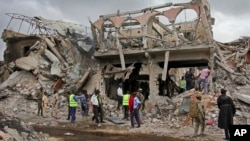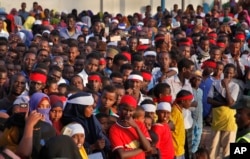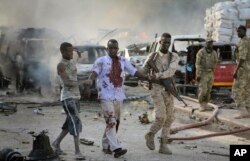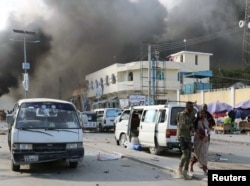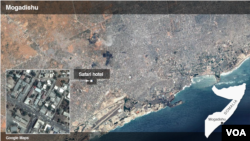The death toll from Saturday's massive truck bombing in the Somali capital Mogadishu - the deadliest terror attack in the country’s history - has topped 270.
Abdirahman O. Osman, Somalia's minister of information, tweeted that the number killed is now 276, with about 300 wounded. He also laid blame for the bombing on the Islamist militant al-Shabab group.
In other tweets, Osman acknowledged Kenya, Ethiopia, and Turkey for sending medical aid to Somalia.
Angry protesters took to the streets condemning al-Shabab. The militant group, which often claims attacks in Mogadishu, has so far stayed silent. But the Somali government and terror experts strongly believe the group was responsible.
"Whether they claim or not claim makes no difference, we know the act that has happened, it’s al-Shabab,” former intelligence officer Abdi Hassan Hussein told VOA. “The information we are getting so far shows this is the work of al-Shabab, it has their hallmarks."
Hundreds of residents on Sunday marched to the scene of the attack, condemning the militant group.
“Where is my child, fight against the wicked, to hell with them, my god condemn the evil” said one elderly angry women. Other protesters shouted anti al-Shabab statements like, “We don’t want blood thirsty elements”.
Some protesters wept as they reached the scene and saw the apocalyptic aftermath of the explosion. The truck bomb turned one of Mogadishu’s most beautiful junctions into death and destruction.
US reaction
In Washington, the U.S. State Department condemned the attack "in the strongest terms."
"In the face of this senseless and cowardly act, the United States will continue to stand with the Somali government, its people, and our international allies to combat terrorism and support their efforts to achieve peace, security, and prosperity," a statement said.
Mohamed Yusuf, a doctor at Medina hospital, described what happened when the explosion happened at around 3:20 pm local time on Saturday.
“We were preparing to leave work for the day but then huge blast occurred, we were shocked, within five minutes ambulances brought in the wounded,” he said. “We have received many dead people, unlike we have ever seen. The hospital is working, we are lacking intensive care equipment, we get support from ICRC but we are still lacking full capacity.”
The victims
Maryan Abdullahi, 21, just finished Banadir University where she studied medicine. She left her voluntary work at Banadir hospital Saturday and was waiting a bus when the explosion occurred. She was killed instantly. He mother Hindo Yuusuf immediately called her number when she heard about the location of the explosion.
“I called her number immediately but someone else answered and they said the owner of the phone died, her body is near the hotel [Safari],” she told VOA Somali.
Abdullahi’s father flew from London Saturday to attend his daughter’s graduation from the university. He arrived in Mogadishu Sunday morning and attended her funeral instead.
Also killed were five members of the same family who were running a clothing shop.
Aweys Moallim Ali is a cousin to the family. He too was wounded in the attack. He said his relatives own two shops but they gathered into one before the explosion.
“They were doing accounting work about the sales made so far so that they can make zakat [alms] payment, they closed the other shop and were meeting in a shop near Hotel Safari,” He said.
VOA reporter
Hundreds were wounded in the attack including VOA reporter in Mogadishu Abdulkadir Mohamed Abdulle.
Abdulle sustained injuries to the neck, hand and burns throughout the body. But he was in good spirits as he spoke about his condition.
“I’m injured in the lower neck, there is shrapnel inside. I have a second injury on the right hand, maybe it’s broken, and third, my body is burned in particular on the torso,” he said. "I have smaller injuries throughout the body, facial injuries, I had about 4 stitches on the face, I have multiple injuries.”
Abdulle recounted what happened at the time of the explosion
“I remember leaving the building near Safari hotel, I wanted to get into my car, as I stepped towards the car the explosion went off, that is all I remember,” he said.
‘The next thing I know is this morning when I woke up at 10am when I saw people standing around my bed.”
The Somali government has called for three days of national mourning and lowering the flag at half-mast. President Mohamed Abdullahi Farmajo has condemned the attack as “barbaric.”
Sahra Ahmed, Asha Aden, Jafar Kukay and Kenneth Schwartz contributed to this report.




